Economic Analysis of UK Housing Market Fluctuations (2006-2016)
VerifiedAdded on 2023/06/13
|19
|3773
|184
Report
AI Summary
This report provides an in-depth analysis of the UK housing market between 2006 and 2016, focusing on the economic factors that influenced its dynamics, particularly price fluctuations and availability. It examines the period leading up to the 2008 Global Financial Crisis, the crisis period itself, and the subsequent recovery phase. The report identifies key drivers such as economic growth, investment attractiveness, and supply-demand imbalances. It also discusses the impact of the financial crisis, including increased unemployment and investment withdrawals. Furthermore, the report explores government policies and measures implemented to address affordability and availability challenges, assessing their implications for potential buyers and the overall economic welfare of the country.
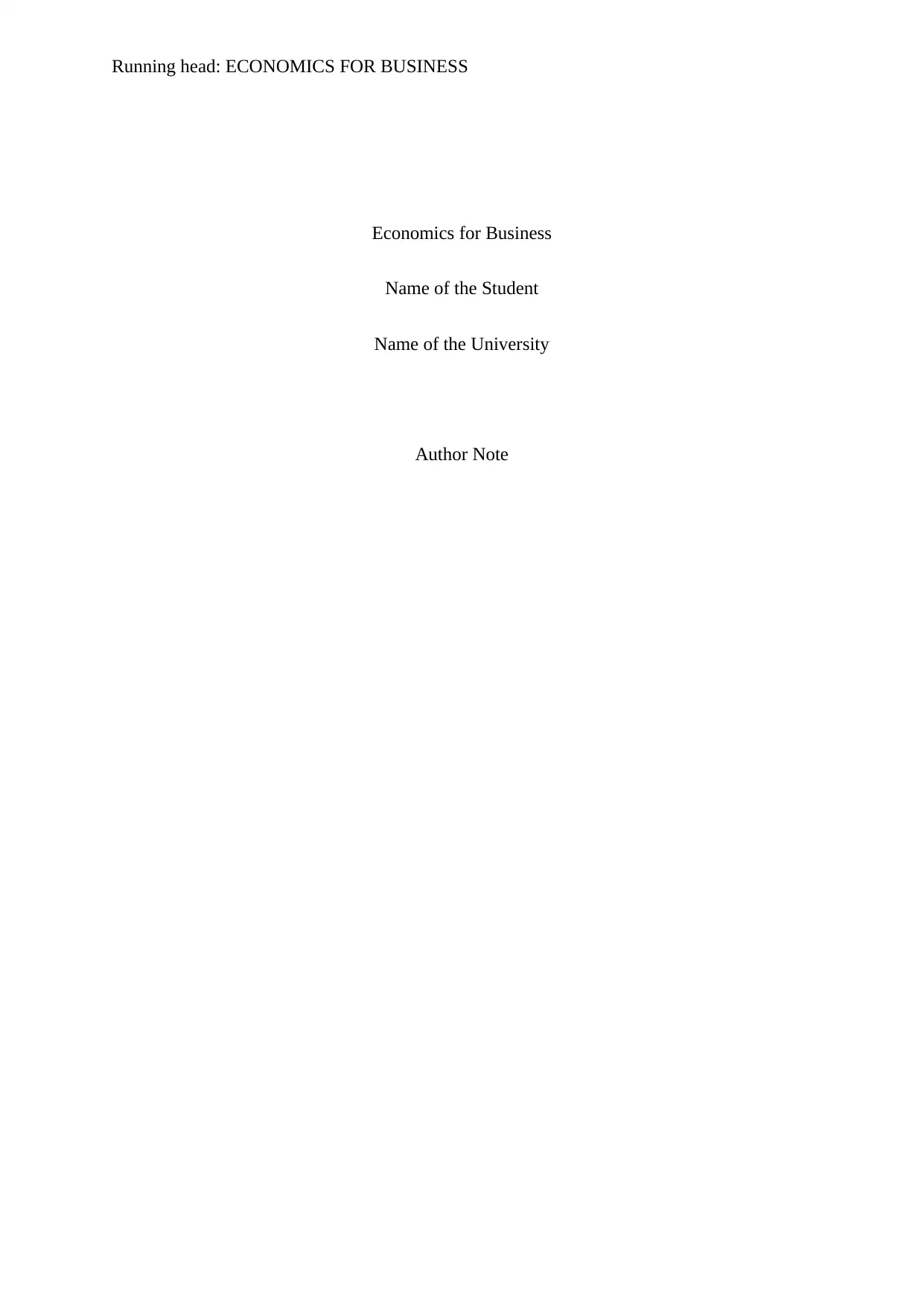
Running head: ECONOMICS FOR BUSINESS
Economics for Business
Name of the Student
Name of the University
Author Note
Economics for Business
Name of the Student
Name of the University
Author Note
Paraphrase This Document
Need a fresh take? Get an instant paraphrase of this document with our AI Paraphraser
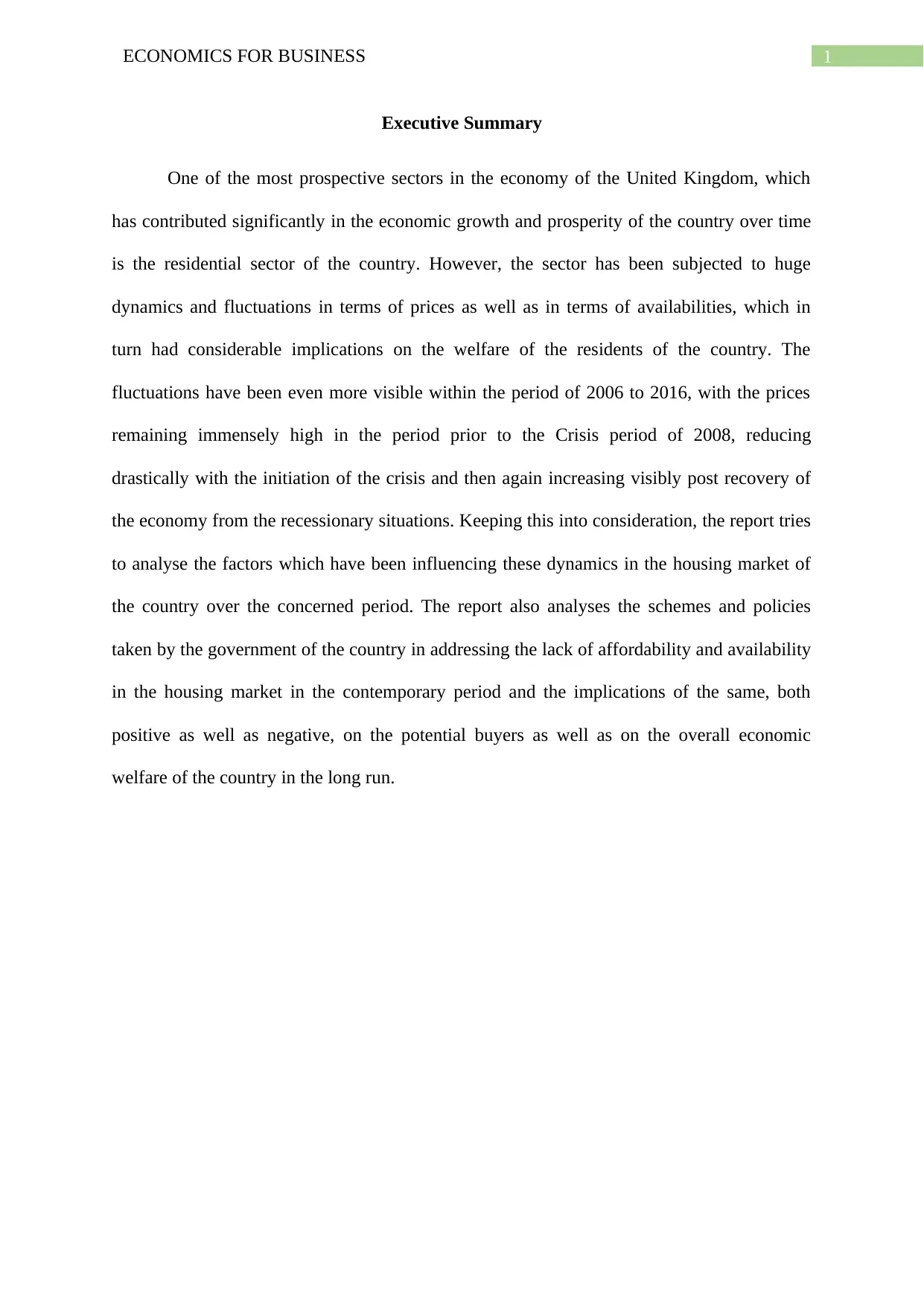
1ECONOMICS FOR BUSINESS
Executive Summary
One of the most prospective sectors in the economy of the United Kingdom, which
has contributed significantly in the economic growth and prosperity of the country over time
is the residential sector of the country. However, the sector has been subjected to huge
dynamics and fluctuations in terms of prices as well as in terms of availabilities, which in
turn had considerable implications on the welfare of the residents of the country. The
fluctuations have been even more visible within the period of 2006 to 2016, with the prices
remaining immensely high in the period prior to the Crisis period of 2008, reducing
drastically with the initiation of the crisis and then again increasing visibly post recovery of
the economy from the recessionary situations. Keeping this into consideration, the report tries
to analyse the factors which have been influencing these dynamics in the housing market of
the country over the concerned period. The report also analyses the schemes and policies
taken by the government of the country in addressing the lack of affordability and availability
in the housing market in the contemporary period and the implications of the same, both
positive as well as negative, on the potential buyers as well as on the overall economic
welfare of the country in the long run.
Executive Summary
One of the most prospective sectors in the economy of the United Kingdom, which
has contributed significantly in the economic growth and prosperity of the country over time
is the residential sector of the country. However, the sector has been subjected to huge
dynamics and fluctuations in terms of prices as well as in terms of availabilities, which in
turn had considerable implications on the welfare of the residents of the country. The
fluctuations have been even more visible within the period of 2006 to 2016, with the prices
remaining immensely high in the period prior to the Crisis period of 2008, reducing
drastically with the initiation of the crisis and then again increasing visibly post recovery of
the economy from the recessionary situations. Keeping this into consideration, the report tries
to analyse the factors which have been influencing these dynamics in the housing market of
the country over the concerned period. The report also analyses the schemes and policies
taken by the government of the country in addressing the lack of affordability and availability
in the housing market in the contemporary period and the implications of the same, both
positive as well as negative, on the potential buyers as well as on the overall economic
welfare of the country in the long run.
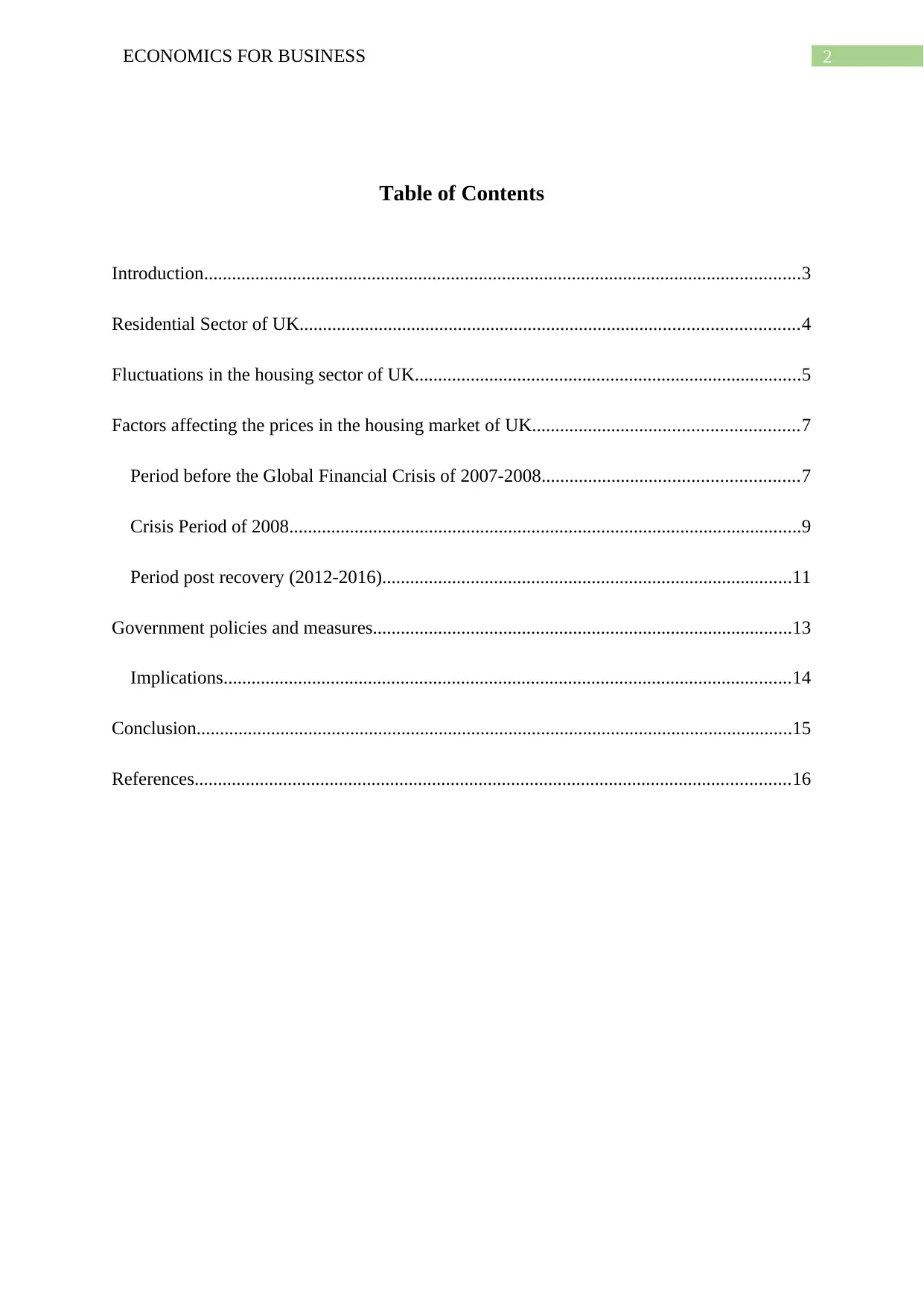
2ECONOMICS FOR BUSINESS
Table of Contents
Introduction................................................................................................................................3
Residential Sector of UK...........................................................................................................4
Fluctuations in the housing sector of UK...................................................................................5
Factors affecting the prices in the housing market of UK.........................................................7
Period before the Global Financial Crisis of 2007-2008.......................................................7
Crisis Period of 2008..............................................................................................................9
Period post recovery (2012-2016)........................................................................................11
Government policies and measures..........................................................................................13
Implications..........................................................................................................................14
Conclusion................................................................................................................................15
References................................................................................................................................16
Table of Contents
Introduction................................................................................................................................3
Residential Sector of UK...........................................................................................................4
Fluctuations in the housing sector of UK...................................................................................5
Factors affecting the prices in the housing market of UK.........................................................7
Period before the Global Financial Crisis of 2007-2008.......................................................7
Crisis Period of 2008..............................................................................................................9
Period post recovery (2012-2016)........................................................................................11
Government policies and measures..........................................................................................13
Implications..........................................................................................................................14
Conclusion................................................................................................................................15
References................................................................................................................................16
⊘ This is a preview!⊘
Do you want full access?
Subscribe today to unlock all pages.

Trusted by 1+ million students worldwide
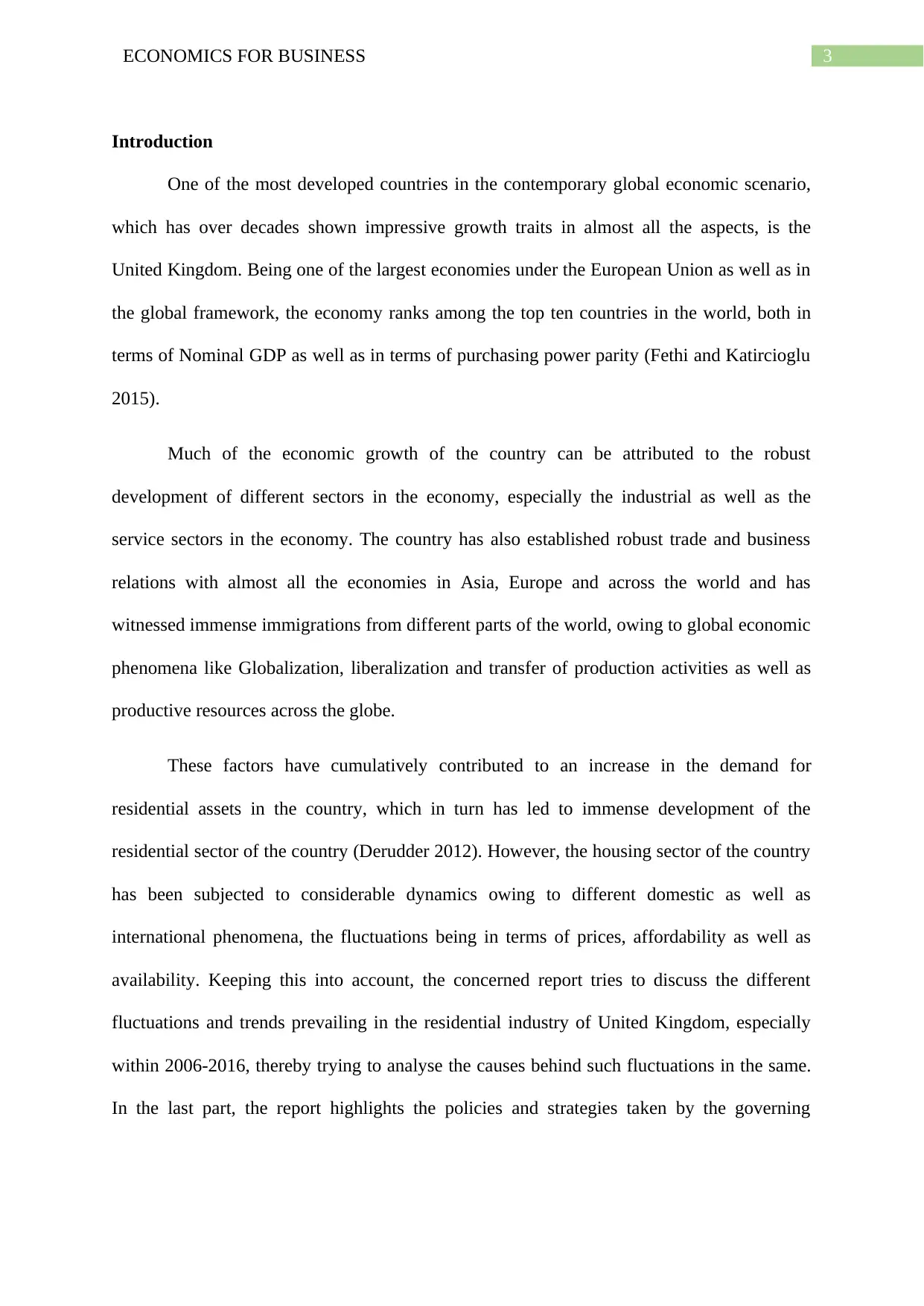
3ECONOMICS FOR BUSINESS
Introduction
One of the most developed countries in the contemporary global economic scenario,
which has over decades shown impressive growth traits in almost all the aspects, is the
United Kingdom. Being one of the largest economies under the European Union as well as in
the global framework, the economy ranks among the top ten countries in the world, both in
terms of Nominal GDP as well as in terms of purchasing power parity (Fethi and Katircioglu
2015).
Much of the economic growth of the country can be attributed to the robust
development of different sectors in the economy, especially the industrial as well as the
service sectors in the economy. The country has also established robust trade and business
relations with almost all the economies in Asia, Europe and across the world and has
witnessed immense immigrations from different parts of the world, owing to global economic
phenomena like Globalization, liberalization and transfer of production activities as well as
productive resources across the globe.
These factors have cumulatively contributed to an increase in the demand for
residential assets in the country, which in turn has led to immense development of the
residential sector of the country (Derudder 2012). However, the housing sector of the country
has been subjected to considerable dynamics owing to different domestic as well as
international phenomena, the fluctuations being in terms of prices, affordability as well as
availability. Keeping this into account, the concerned report tries to discuss the different
fluctuations and trends prevailing in the residential industry of United Kingdom, especially
within 2006-2016, thereby trying to analyse the causes behind such fluctuations in the same.
In the last part, the report highlights the policies and strategies taken by the governing
Introduction
One of the most developed countries in the contemporary global economic scenario,
which has over decades shown impressive growth traits in almost all the aspects, is the
United Kingdom. Being one of the largest economies under the European Union as well as in
the global framework, the economy ranks among the top ten countries in the world, both in
terms of Nominal GDP as well as in terms of purchasing power parity (Fethi and Katircioglu
2015).
Much of the economic growth of the country can be attributed to the robust
development of different sectors in the economy, especially the industrial as well as the
service sectors in the economy. The country has also established robust trade and business
relations with almost all the economies in Asia, Europe and across the world and has
witnessed immense immigrations from different parts of the world, owing to global economic
phenomena like Globalization, liberalization and transfer of production activities as well as
productive resources across the globe.
These factors have cumulatively contributed to an increase in the demand for
residential assets in the country, which in turn has led to immense development of the
residential sector of the country (Derudder 2012). However, the housing sector of the country
has been subjected to considerable dynamics owing to different domestic as well as
international phenomena, the fluctuations being in terms of prices, affordability as well as
availability. Keeping this into account, the concerned report tries to discuss the different
fluctuations and trends prevailing in the residential industry of United Kingdom, especially
within 2006-2016, thereby trying to analyse the causes behind such fluctuations in the same.
In the last part, the report highlights the policies and strategies taken by the governing
Paraphrase This Document
Need a fresh take? Get an instant paraphrase of this document with our AI Paraphraser
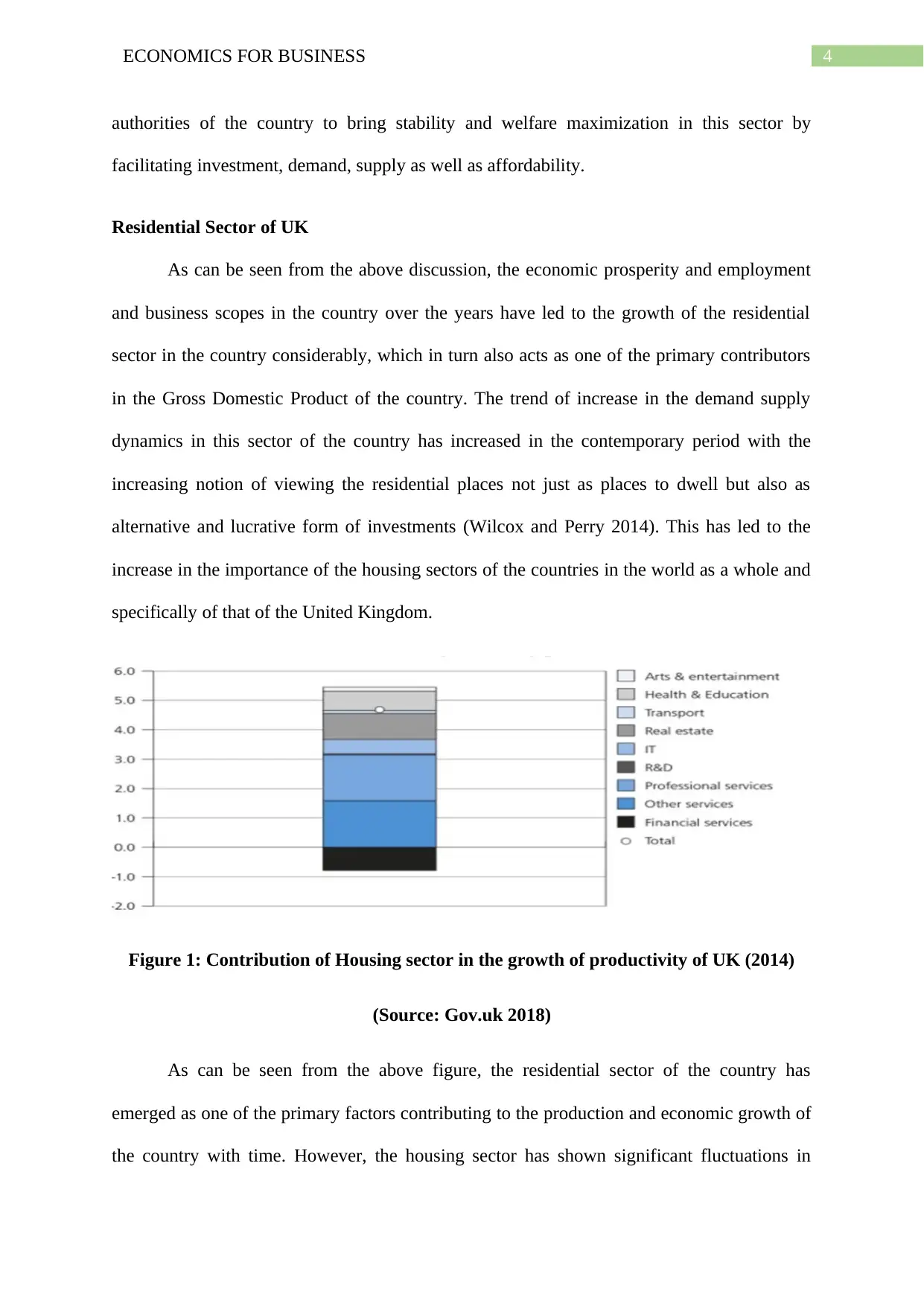
4ECONOMICS FOR BUSINESS
authorities of the country to bring stability and welfare maximization in this sector by
facilitating investment, demand, supply as well as affordability.
Residential Sector of UK
As can be seen from the above discussion, the economic prosperity and employment
and business scopes in the country over the years have led to the growth of the residential
sector in the country considerably, which in turn also acts as one of the primary contributors
in the Gross Domestic Product of the country. The trend of increase in the demand supply
dynamics in this sector of the country has increased in the contemporary period with the
increasing notion of viewing the residential places not just as places to dwell but also as
alternative and lucrative form of investments (Wilcox and Perry 2014). This has led to the
increase in the importance of the housing sectors of the countries in the world as a whole and
specifically of that of the United Kingdom.
Figure 1: Contribution of Housing sector in the growth of productivity of UK (2014)
(Source: Gov.uk 2018)
As can be seen from the above figure, the residential sector of the country has
emerged as one of the primary factors contributing to the production and economic growth of
the country with time. However, the housing sector has shown significant fluctuations in
authorities of the country to bring stability and welfare maximization in this sector by
facilitating investment, demand, supply as well as affordability.
Residential Sector of UK
As can be seen from the above discussion, the economic prosperity and employment
and business scopes in the country over the years have led to the growth of the residential
sector in the country considerably, which in turn also acts as one of the primary contributors
in the Gross Domestic Product of the country. The trend of increase in the demand supply
dynamics in this sector of the country has increased in the contemporary period with the
increasing notion of viewing the residential places not just as places to dwell but also as
alternative and lucrative form of investments (Wilcox and Perry 2014). This has led to the
increase in the importance of the housing sectors of the countries in the world as a whole and
specifically of that of the United Kingdom.
Figure 1: Contribution of Housing sector in the growth of productivity of UK (2014)
(Source: Gov.uk 2018)
As can be seen from the above figure, the residential sector of the country has
emerged as one of the primary factors contributing to the production and economic growth of
the country with time. However, the housing sector has shown significant fluctuations in
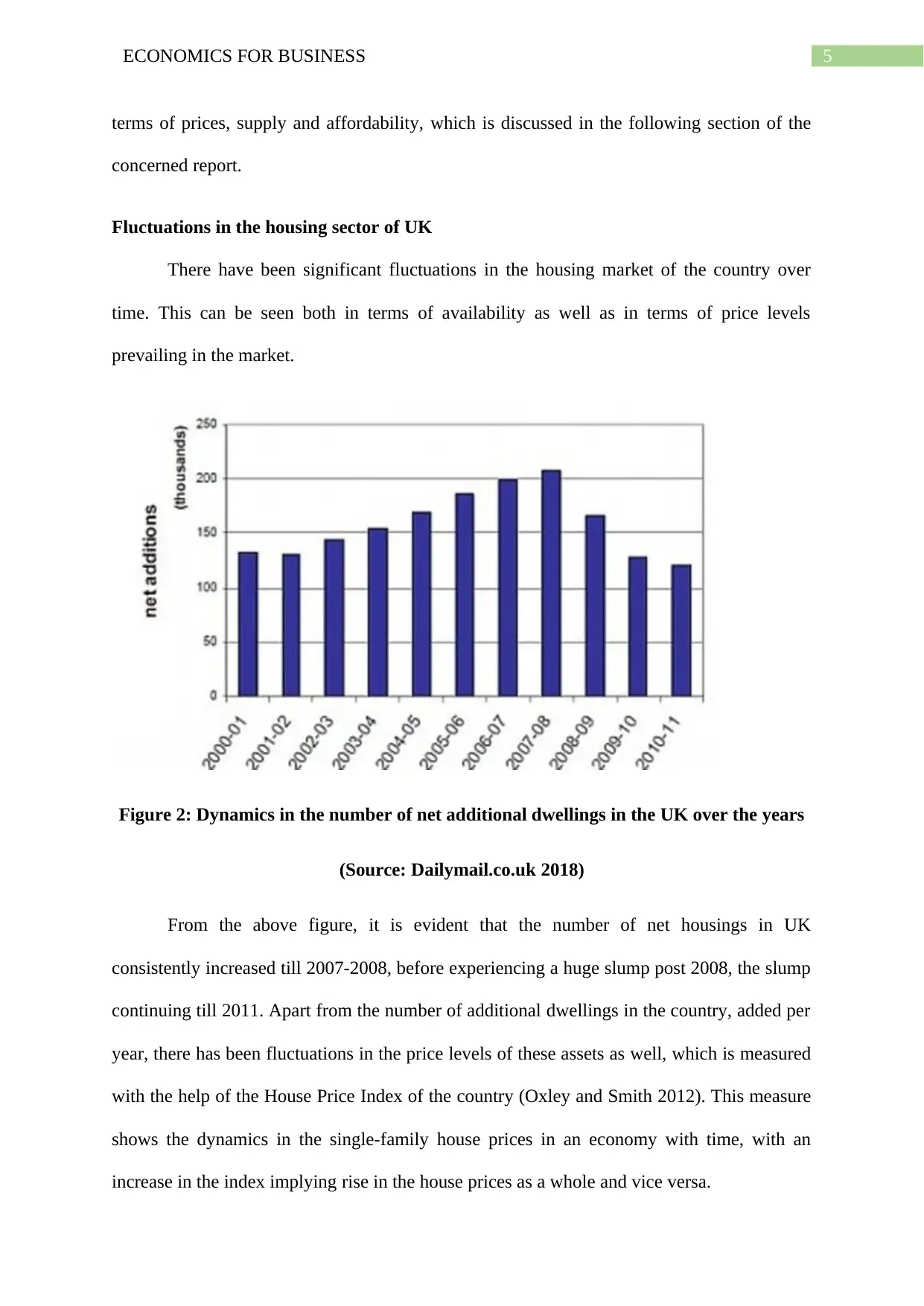
5ECONOMICS FOR BUSINESS
terms of prices, supply and affordability, which is discussed in the following section of the
concerned report.
Fluctuations in the housing sector of UK
There have been significant fluctuations in the housing market of the country over
time. This can be seen both in terms of availability as well as in terms of price levels
prevailing in the market.
Figure 2: Dynamics in the number of net additional dwellings in the UK over the years
(Source: Dailymail.co.uk 2018)
From the above figure, it is evident that the number of net housings in UK
consistently increased till 2007-2008, before experiencing a huge slump post 2008, the slump
continuing till 2011. Apart from the number of additional dwellings in the country, added per
year, there has been fluctuations in the price levels of these assets as well, which is measured
with the help of the House Price Index of the country (Oxley and Smith 2012). This measure
shows the dynamics in the single-family house prices in an economy with time, with an
increase in the index implying rise in the house prices as a whole and vice versa.
terms of prices, supply and affordability, which is discussed in the following section of the
concerned report.
Fluctuations in the housing sector of UK
There have been significant fluctuations in the housing market of the country over
time. This can be seen both in terms of availability as well as in terms of price levels
prevailing in the market.
Figure 2: Dynamics in the number of net additional dwellings in the UK over the years
(Source: Dailymail.co.uk 2018)
From the above figure, it is evident that the number of net housings in UK
consistently increased till 2007-2008, before experiencing a huge slump post 2008, the slump
continuing till 2011. Apart from the number of additional dwellings in the country, added per
year, there has been fluctuations in the price levels of these assets as well, which is measured
with the help of the House Price Index of the country (Oxley and Smith 2012). This measure
shows the dynamics in the single-family house prices in an economy with time, with an
increase in the index implying rise in the house prices as a whole and vice versa.
⊘ This is a preview!⊘
Do you want full access?
Subscribe today to unlock all pages.

Trusted by 1+ million students worldwide
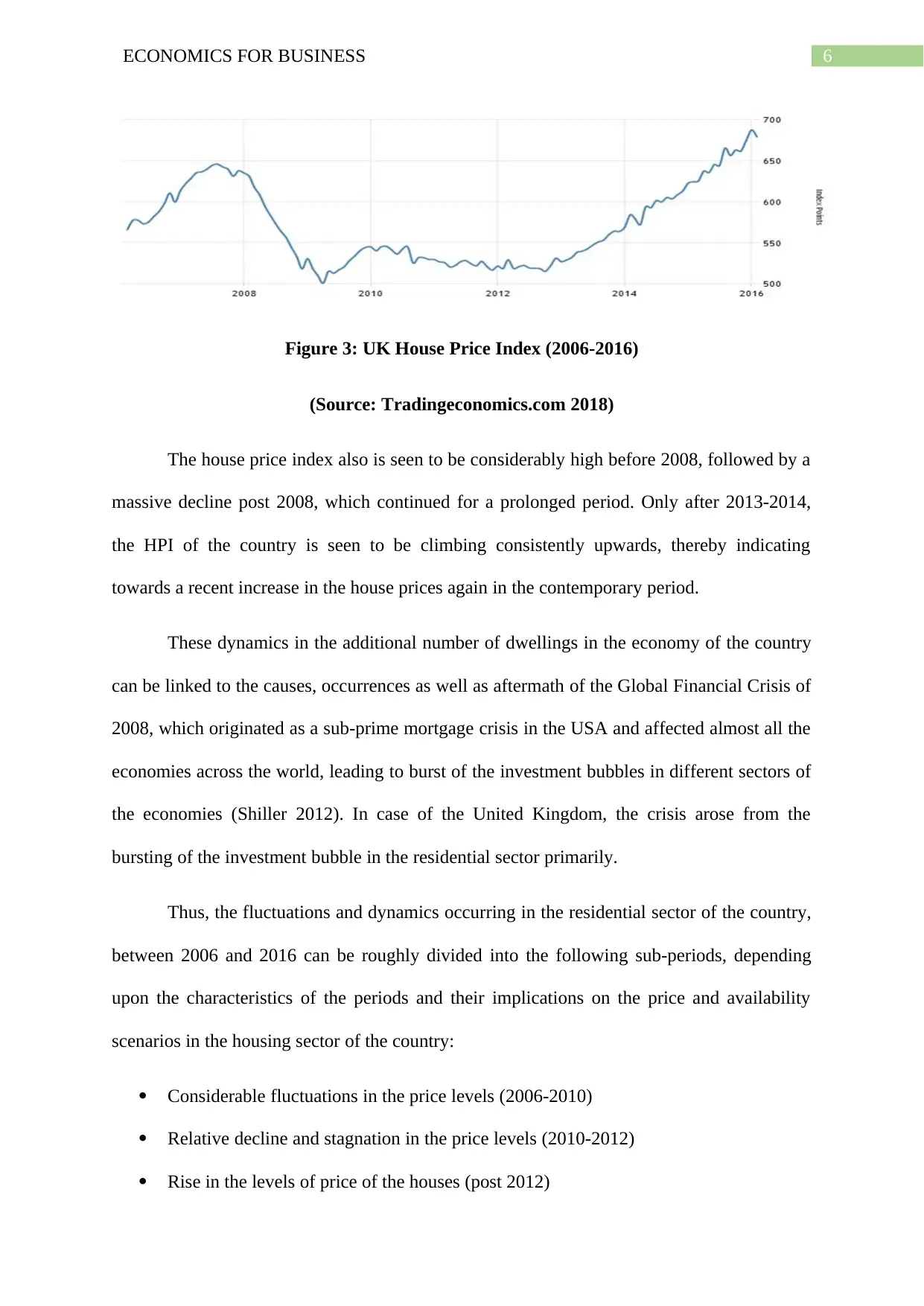
6ECONOMICS FOR BUSINESS
Figure 3: UK House Price Index (2006-2016)
(Source: Tradingeconomics.com 2018)
The house price index also is seen to be considerably high before 2008, followed by a
massive decline post 2008, which continued for a prolonged period. Only after 2013-2014,
the HPI of the country is seen to be climbing consistently upwards, thereby indicating
towards a recent increase in the house prices again in the contemporary period.
These dynamics in the additional number of dwellings in the economy of the country
can be linked to the causes, occurrences as well as aftermath of the Global Financial Crisis of
2008, which originated as a sub-prime mortgage crisis in the USA and affected almost all the
economies across the world, leading to burst of the investment bubbles in different sectors of
the economies (Shiller 2012). In case of the United Kingdom, the crisis arose from the
bursting of the investment bubble in the residential sector primarily.
Thus, the fluctuations and dynamics occurring in the residential sector of the country,
between 2006 and 2016 can be roughly divided into the following sub-periods, depending
upon the characteristics of the periods and their implications on the price and availability
scenarios in the housing sector of the country:
Considerable fluctuations in the price levels (2006-2010)
Relative decline and stagnation in the price levels (2010-2012)
Rise in the levels of price of the houses (post 2012)
Figure 3: UK House Price Index (2006-2016)
(Source: Tradingeconomics.com 2018)
The house price index also is seen to be considerably high before 2008, followed by a
massive decline post 2008, which continued for a prolonged period. Only after 2013-2014,
the HPI of the country is seen to be climbing consistently upwards, thereby indicating
towards a recent increase in the house prices again in the contemporary period.
These dynamics in the additional number of dwellings in the economy of the country
can be linked to the causes, occurrences as well as aftermath of the Global Financial Crisis of
2008, which originated as a sub-prime mortgage crisis in the USA and affected almost all the
economies across the world, leading to burst of the investment bubbles in different sectors of
the economies (Shiller 2012). In case of the United Kingdom, the crisis arose from the
bursting of the investment bubble in the residential sector primarily.
Thus, the fluctuations and dynamics occurring in the residential sector of the country,
between 2006 and 2016 can be roughly divided into the following sub-periods, depending
upon the characteristics of the periods and their implications on the price and availability
scenarios in the housing sector of the country:
Considerable fluctuations in the price levels (2006-2010)
Relative decline and stagnation in the price levels (2010-2012)
Rise in the levels of price of the houses (post 2012)
Paraphrase This Document
Need a fresh take? Get an instant paraphrase of this document with our AI Paraphraser
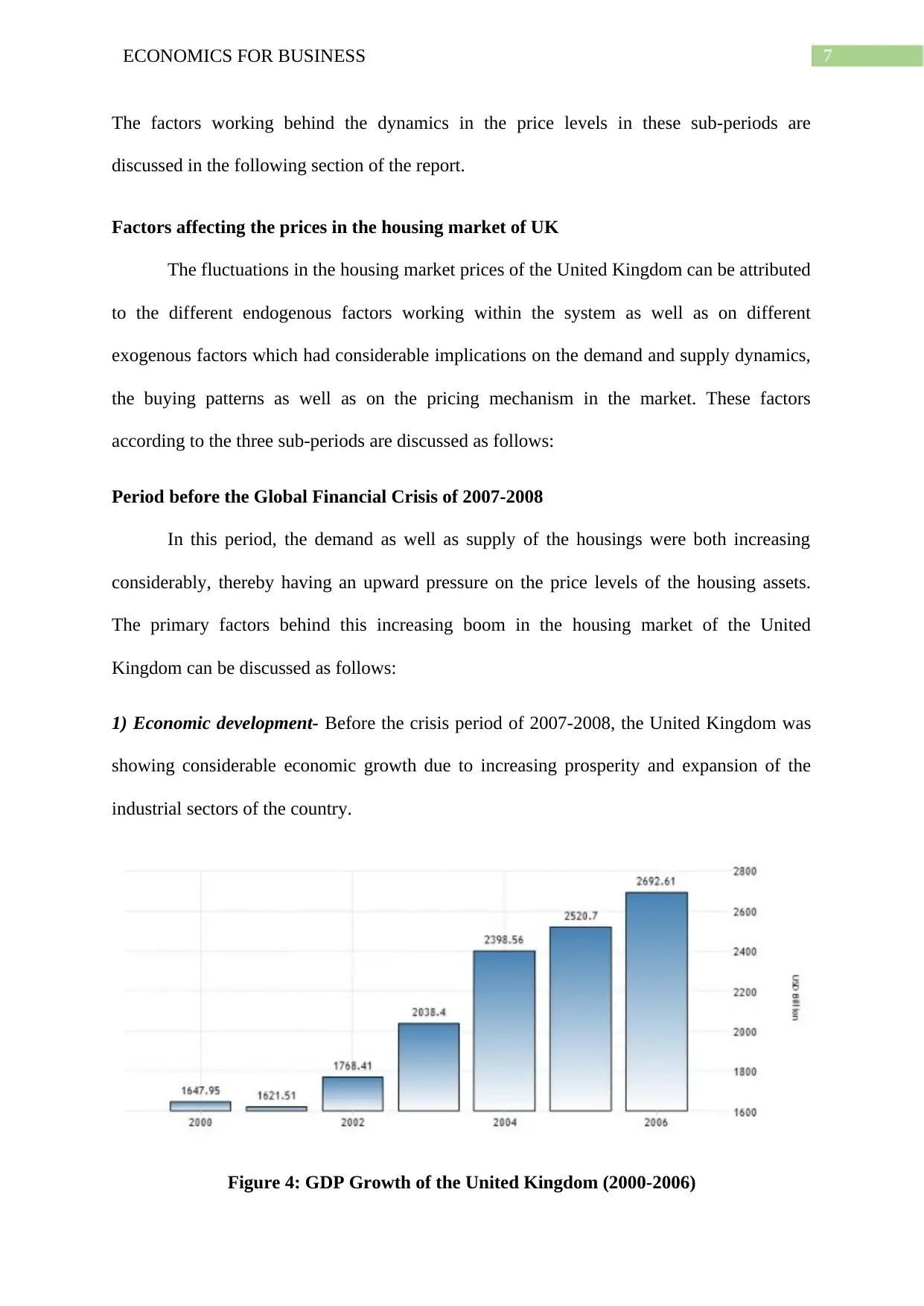
7ECONOMICS FOR BUSINESS
The factors working behind the dynamics in the price levels in these sub-periods are
discussed in the following section of the report.
Factors affecting the prices in the housing market of UK
The fluctuations in the housing market prices of the United Kingdom can be attributed
to the different endogenous factors working within the system as well as on different
exogenous factors which had considerable implications on the demand and supply dynamics,
the buying patterns as well as on the pricing mechanism in the market. These factors
according to the three sub-periods are discussed as follows:
Period before the Global Financial Crisis of 2007-2008
In this period, the demand as well as supply of the housings were both increasing
considerably, thereby having an upward pressure on the price levels of the housing assets.
The primary factors behind this increasing boom in the housing market of the United
Kingdom can be discussed as follows:
1) Economic development- Before the crisis period of 2007-2008, the United Kingdom was
showing considerable economic growth due to increasing prosperity and expansion of the
industrial sectors of the country.
Figure 4: GDP Growth of the United Kingdom (2000-2006)
The factors working behind the dynamics in the price levels in these sub-periods are
discussed in the following section of the report.
Factors affecting the prices in the housing market of UK
The fluctuations in the housing market prices of the United Kingdom can be attributed
to the different endogenous factors working within the system as well as on different
exogenous factors which had considerable implications on the demand and supply dynamics,
the buying patterns as well as on the pricing mechanism in the market. These factors
according to the three sub-periods are discussed as follows:
Period before the Global Financial Crisis of 2007-2008
In this period, the demand as well as supply of the housings were both increasing
considerably, thereby having an upward pressure on the price levels of the housing assets.
The primary factors behind this increasing boom in the housing market of the United
Kingdom can be discussed as follows:
1) Economic development- Before the crisis period of 2007-2008, the United Kingdom was
showing considerable economic growth due to increasing prosperity and expansion of the
industrial sectors of the country.
Figure 4: GDP Growth of the United Kingdom (2000-2006)
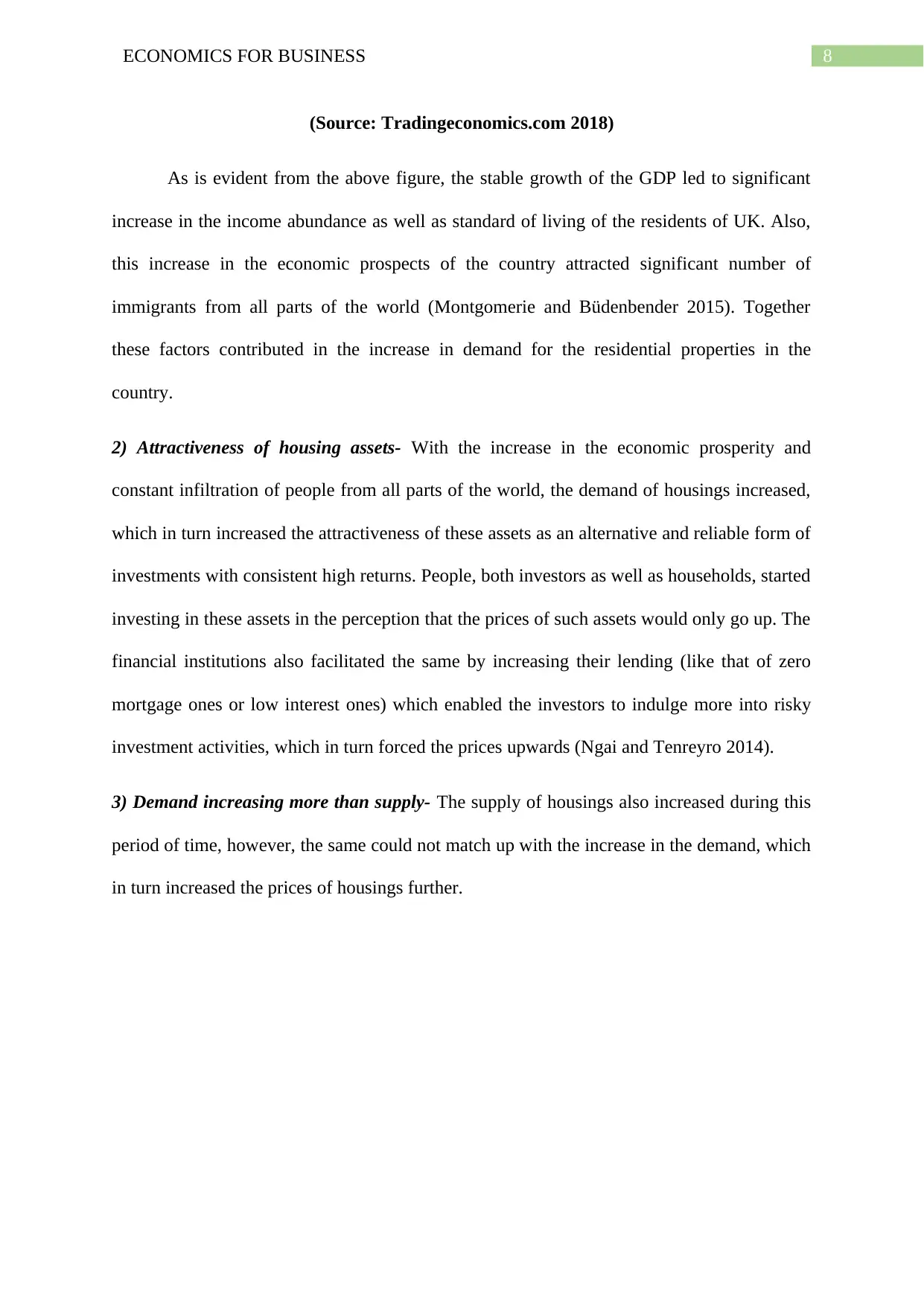
8ECONOMICS FOR BUSINESS
(Source: Tradingeconomics.com 2018)
As is evident from the above figure, the stable growth of the GDP led to significant
increase in the income abundance as well as standard of living of the residents of UK. Also,
this increase in the economic prospects of the country attracted significant number of
immigrants from all parts of the world (Montgomerie and Büdenbender 2015). Together
these factors contributed in the increase in demand for the residential properties in the
country.
2) Attractiveness of housing assets- With the increase in the economic prosperity and
constant infiltration of people from all parts of the world, the demand of housings increased,
which in turn increased the attractiveness of these assets as an alternative and reliable form of
investments with consistent high returns. People, both investors as well as households, started
investing in these assets in the perception that the prices of such assets would only go up. The
financial institutions also facilitated the same by increasing their lending (like that of zero
mortgage ones or low interest ones) which enabled the investors to indulge more into risky
investment activities, which in turn forced the prices upwards (Ngai and Tenreyro 2014).
3) Demand increasing more than supply- The supply of housings also increased during this
period of time, however, the same could not match up with the increase in the demand, which
in turn increased the prices of housings further.
(Source: Tradingeconomics.com 2018)
As is evident from the above figure, the stable growth of the GDP led to significant
increase in the income abundance as well as standard of living of the residents of UK. Also,
this increase in the economic prospects of the country attracted significant number of
immigrants from all parts of the world (Montgomerie and Büdenbender 2015). Together
these factors contributed in the increase in demand for the residential properties in the
country.
2) Attractiveness of housing assets- With the increase in the economic prosperity and
constant infiltration of people from all parts of the world, the demand of housings increased,
which in turn increased the attractiveness of these assets as an alternative and reliable form of
investments with consistent high returns. People, both investors as well as households, started
investing in these assets in the perception that the prices of such assets would only go up. The
financial institutions also facilitated the same by increasing their lending (like that of zero
mortgage ones or low interest ones) which enabled the investors to indulge more into risky
investment activities, which in turn forced the prices upwards (Ngai and Tenreyro 2014).
3) Demand increasing more than supply- The supply of housings also increased during this
period of time, however, the same could not match up with the increase in the demand, which
in turn increased the prices of housings further.
⊘ This is a preview!⊘
Do you want full access?
Subscribe today to unlock all pages.

Trusted by 1+ million students worldwide
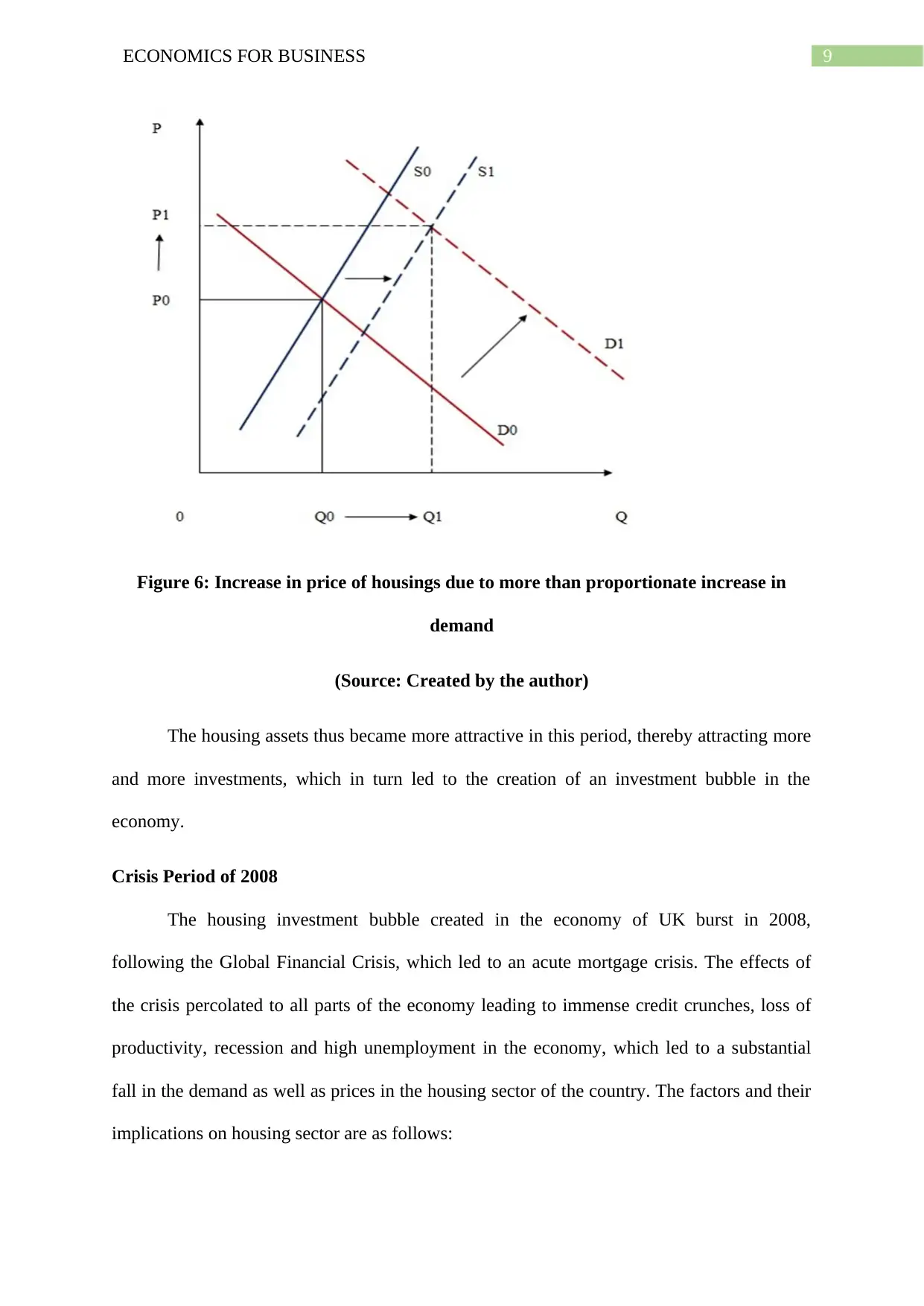
9ECONOMICS FOR BUSINESS
Figure 6: Increase in price of housings due to more than proportionate increase in
demand
(Source: Created by the author)
The housing assets thus became more attractive in this period, thereby attracting more
and more investments, which in turn led to the creation of an investment bubble in the
economy.
Crisis Period of 2008
The housing investment bubble created in the economy of UK burst in 2008,
following the Global Financial Crisis, which led to an acute mortgage crisis. The effects of
the crisis percolated to all parts of the economy leading to immense credit crunches, loss of
productivity, recession and high unemployment in the economy, which led to a substantial
fall in the demand as well as prices in the housing sector of the country. The factors and their
implications on housing sector are as follows:
Figure 6: Increase in price of housings due to more than proportionate increase in
demand
(Source: Created by the author)
The housing assets thus became more attractive in this period, thereby attracting more
and more investments, which in turn led to the creation of an investment bubble in the
economy.
Crisis Period of 2008
The housing investment bubble created in the economy of UK burst in 2008,
following the Global Financial Crisis, which led to an acute mortgage crisis. The effects of
the crisis percolated to all parts of the economy leading to immense credit crunches, loss of
productivity, recession and high unemployment in the economy, which led to a substantial
fall in the demand as well as prices in the housing sector of the country. The factors and their
implications on housing sector are as follows:
Paraphrase This Document
Need a fresh take? Get an instant paraphrase of this document with our AI Paraphraser
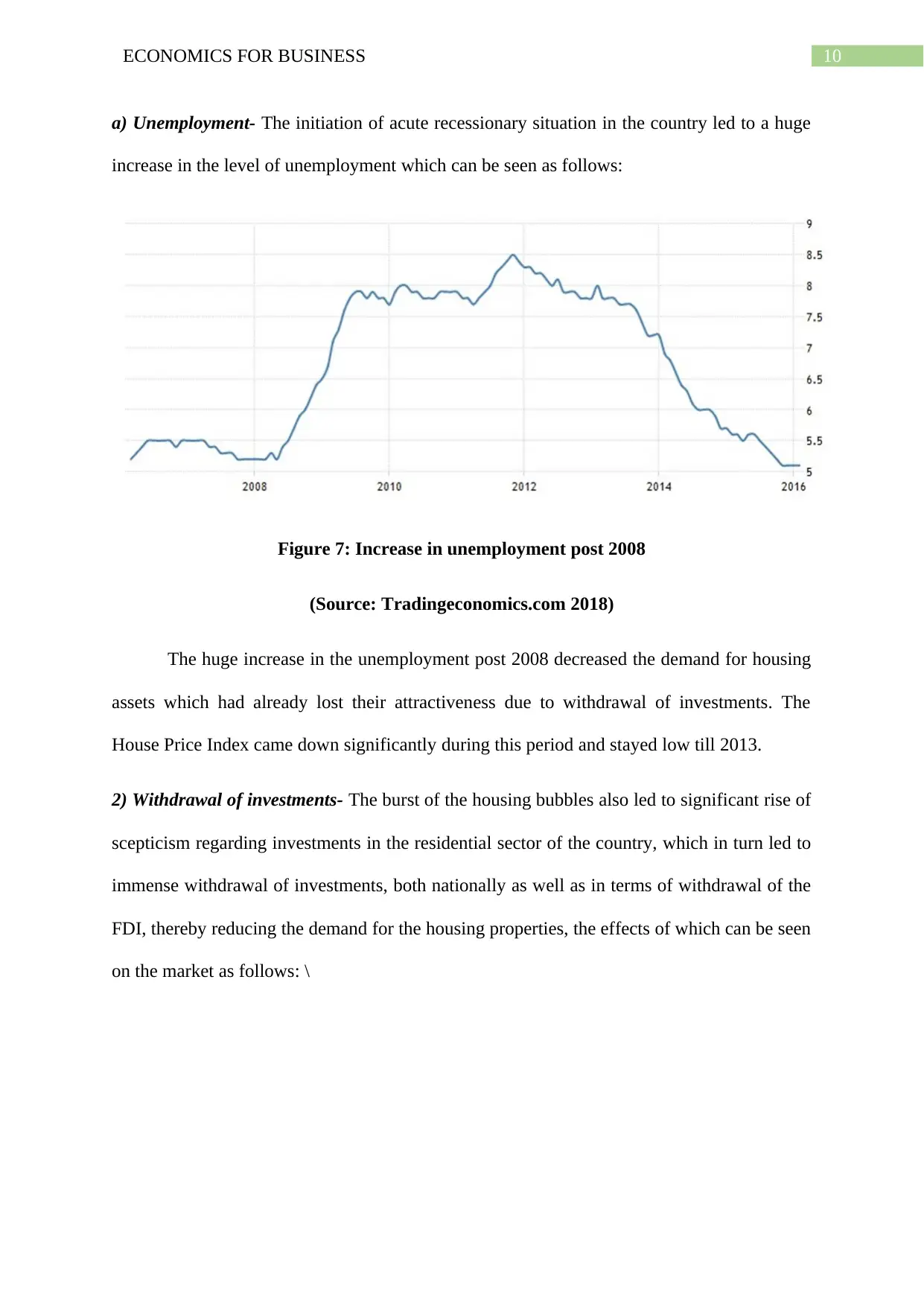
10ECONOMICS FOR BUSINESS
a) Unemployment- The initiation of acute recessionary situation in the country led to a huge
increase in the level of unemployment which can be seen as follows:
Figure 7: Increase in unemployment post 2008
(Source: Tradingeconomics.com 2018)
The huge increase in the unemployment post 2008 decreased the demand for housing
assets which had already lost their attractiveness due to withdrawal of investments. The
House Price Index came down significantly during this period and stayed low till 2013.
2) Withdrawal of investments- The burst of the housing bubbles also led to significant rise of
scepticism regarding investments in the residential sector of the country, which in turn led to
immense withdrawal of investments, both nationally as well as in terms of withdrawal of the
FDI, thereby reducing the demand for the housing properties, the effects of which can be seen
on the market as follows: \
a) Unemployment- The initiation of acute recessionary situation in the country led to a huge
increase in the level of unemployment which can be seen as follows:
Figure 7: Increase in unemployment post 2008
(Source: Tradingeconomics.com 2018)
The huge increase in the unemployment post 2008 decreased the demand for housing
assets which had already lost their attractiveness due to withdrawal of investments. The
House Price Index came down significantly during this period and stayed low till 2013.
2) Withdrawal of investments- The burst of the housing bubbles also led to significant rise of
scepticism regarding investments in the residential sector of the country, which in turn led to
immense withdrawal of investments, both nationally as well as in terms of withdrawal of the
FDI, thereby reducing the demand for the housing properties, the effects of which can be seen
on the market as follows: \
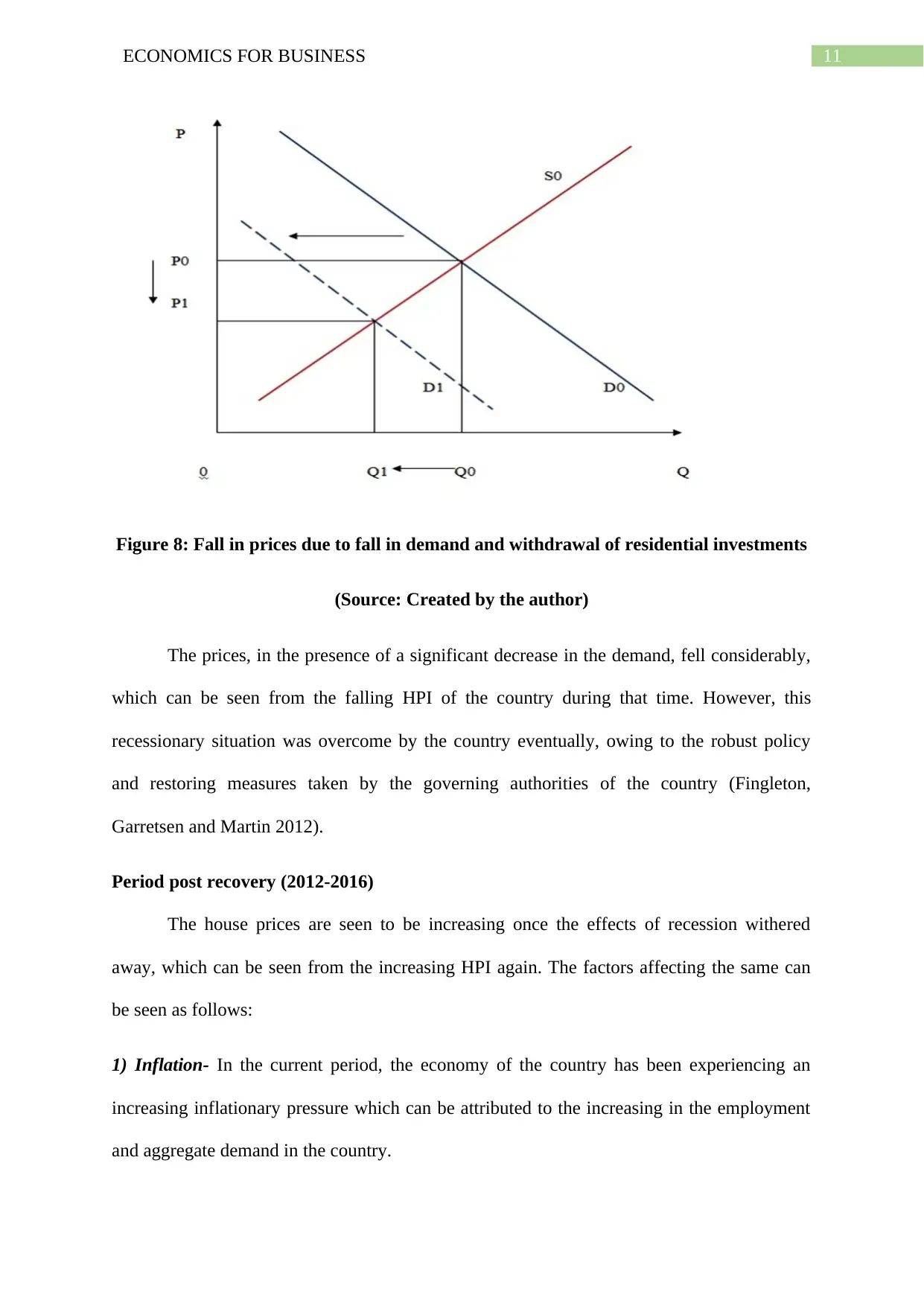
11ECONOMICS FOR BUSINESS
Figure 8: Fall in prices due to fall in demand and withdrawal of residential investments
(Source: Created by the author)
The prices, in the presence of a significant decrease in the demand, fell considerably,
which can be seen from the falling HPI of the country during that time. However, this
recessionary situation was overcome by the country eventually, owing to the robust policy
and restoring measures taken by the governing authorities of the country (Fingleton,
Garretsen and Martin 2012).
Period post recovery (2012-2016)
The house prices are seen to be increasing once the effects of recession withered
away, which can be seen from the increasing HPI again. The factors affecting the same can
be seen as follows:
1) Inflation- In the current period, the economy of the country has been experiencing an
increasing inflationary pressure which can be attributed to the increasing in the employment
and aggregate demand in the country.
Figure 8: Fall in prices due to fall in demand and withdrawal of residential investments
(Source: Created by the author)
The prices, in the presence of a significant decrease in the demand, fell considerably,
which can be seen from the falling HPI of the country during that time. However, this
recessionary situation was overcome by the country eventually, owing to the robust policy
and restoring measures taken by the governing authorities of the country (Fingleton,
Garretsen and Martin 2012).
Period post recovery (2012-2016)
The house prices are seen to be increasing once the effects of recession withered
away, which can be seen from the increasing HPI again. The factors affecting the same can
be seen as follows:
1) Inflation- In the current period, the economy of the country has been experiencing an
increasing inflationary pressure which can be attributed to the increasing in the employment
and aggregate demand in the country.
⊘ This is a preview!⊘
Do you want full access?
Subscribe today to unlock all pages.

Trusted by 1+ million students worldwide
1 out of 19
Related Documents
Your All-in-One AI-Powered Toolkit for Academic Success.
+13062052269
info@desklib.com
Available 24*7 on WhatsApp / Email
![[object Object]](/_next/static/media/star-bottom.7253800d.svg)
Unlock your academic potential
Copyright © 2020–2025 A2Z Services. All Rights Reserved. Developed and managed by ZUCOL.




